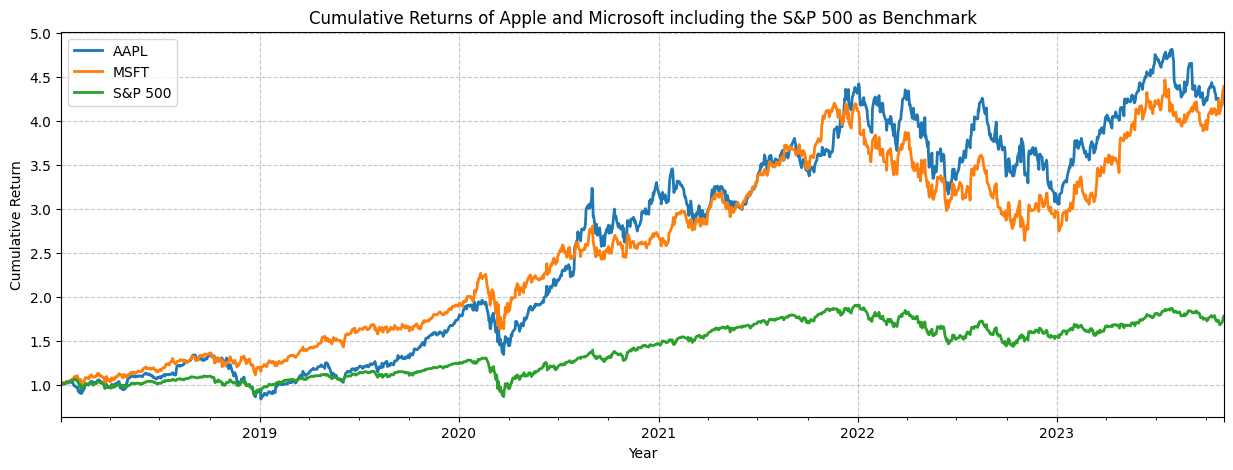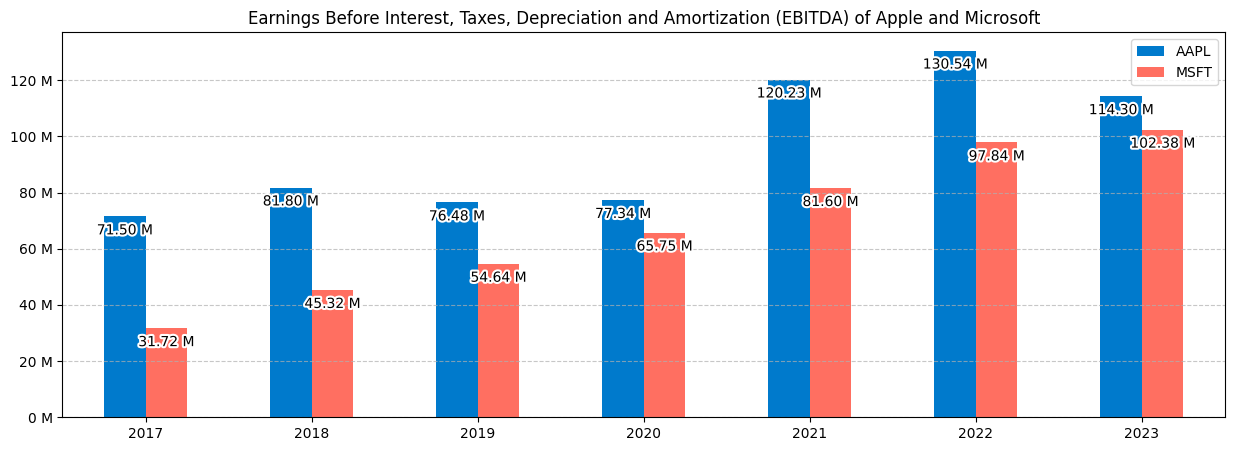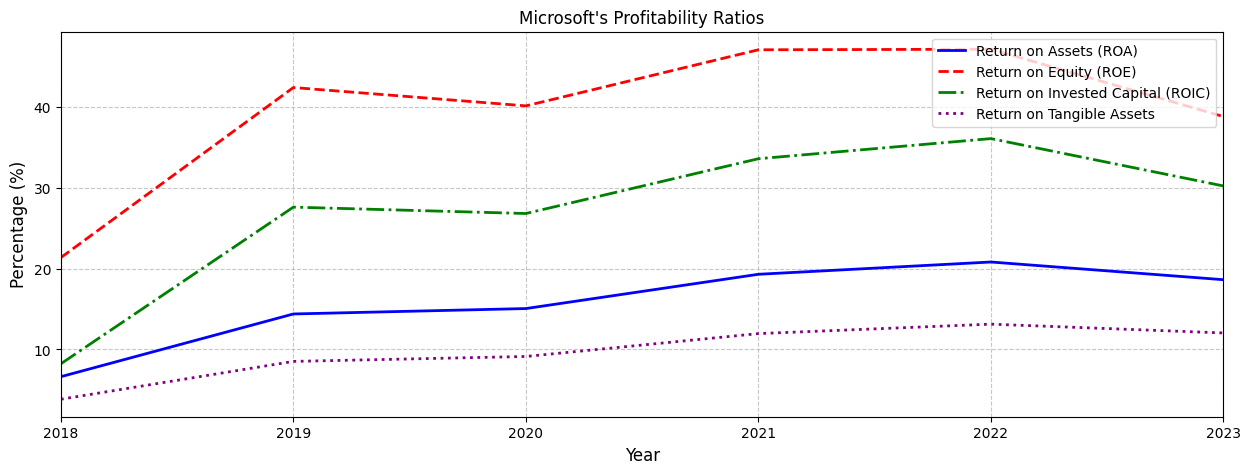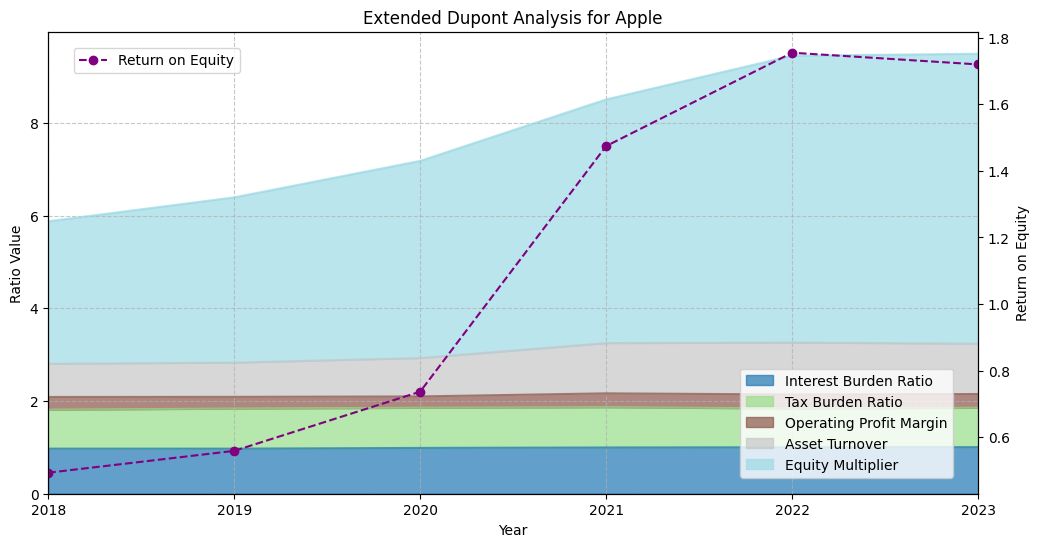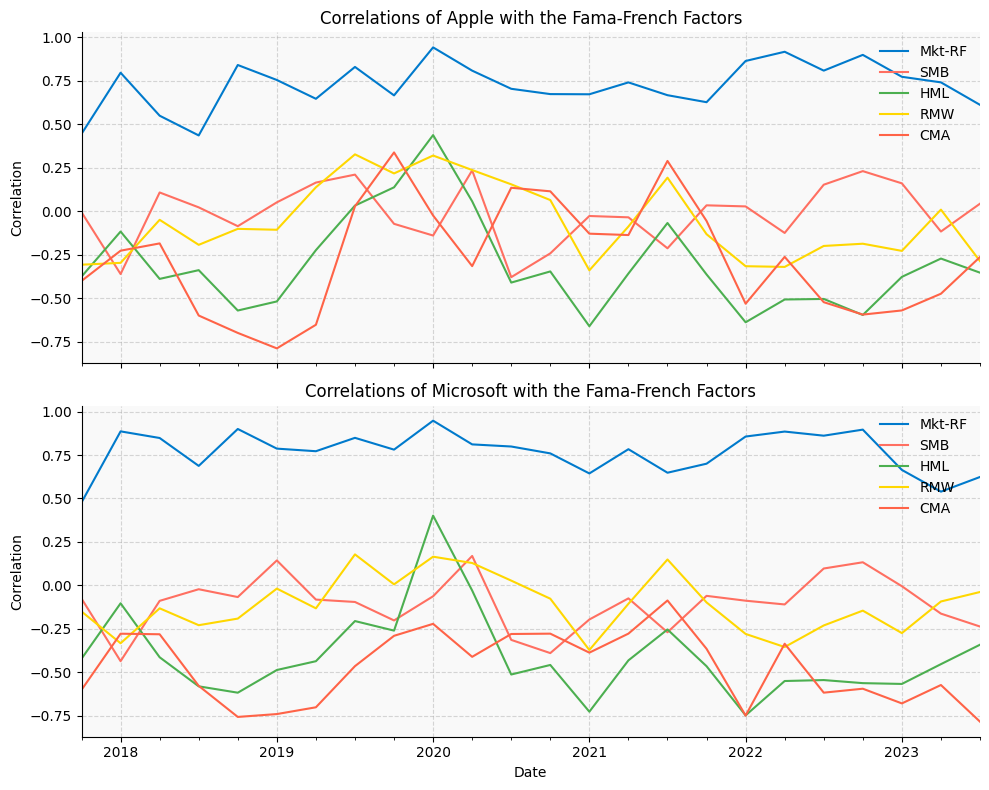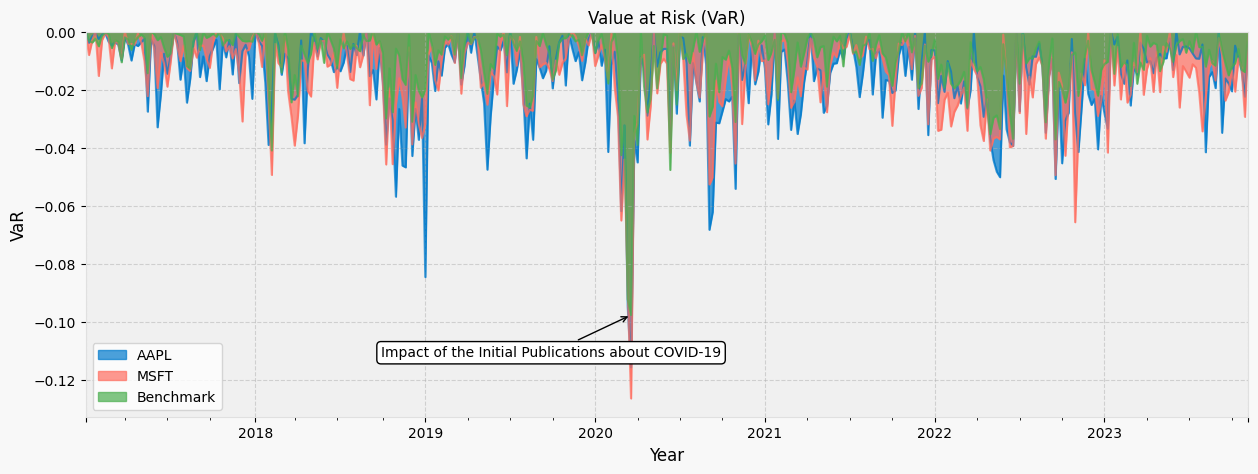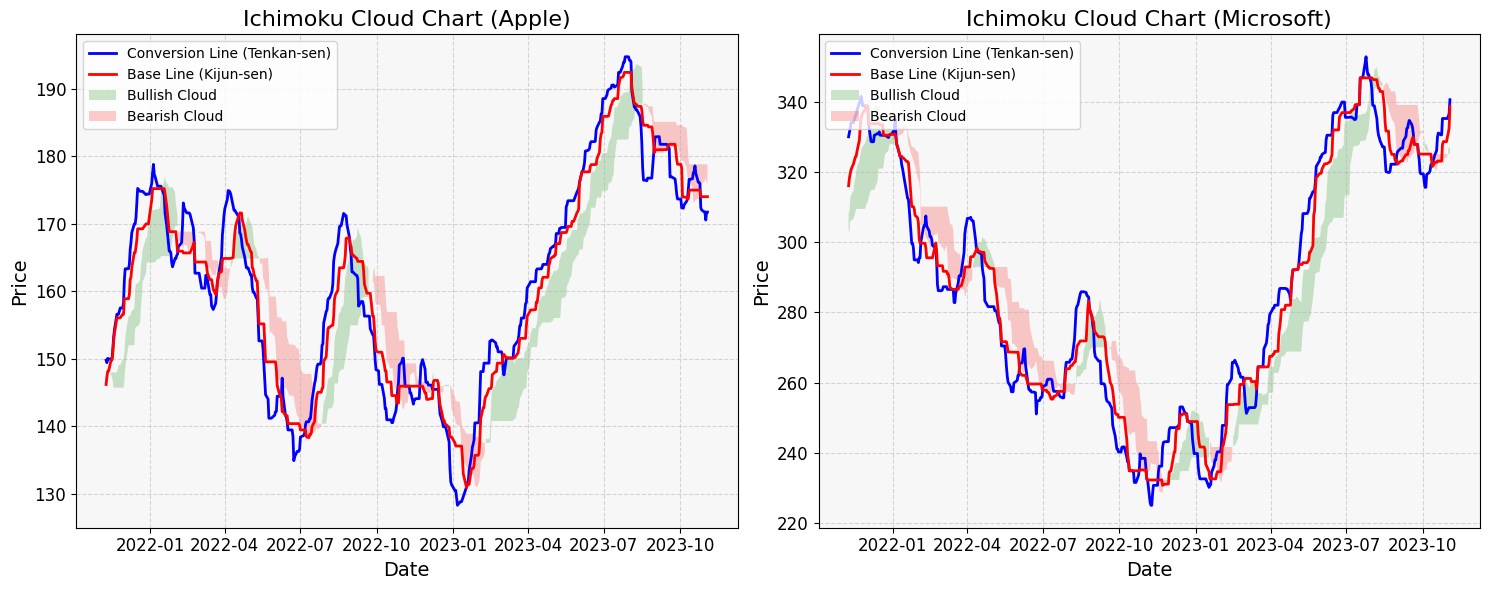Transparent and Efficient Financial Analysis
Project description
While browsing a variety of websites, I kept finding that the same financial metric can greatly vary per source and so do the financial statements reported while little information is given how the metric was calculated.
For example, Microsoft's Price-to-Earnings (PE) ratio on the 6th of May, 2023 is reported to be 28.93 (Stockopedia), 32.05 (Morningstar), 32.66 (Macrotrends), 33.09 (Finance Charts), 33.66 (Y Charts), 33.67 (Wall Street Journal), 33.80 (Yahoo Finance) and 34.4 (Companies Market Cap). All of these calculations are correct, however the method applied varies leading to different results. Therefore, collecting data from multiple sources can lead to wrong interpretation of the results given that one source could be applying a different calculation method than another. And that is, if it is even freely available. Often the calculation is hidden behind a paid subscription.
This is why I designed the FinanceToolkit, this is an open-source toolkit in which all relevant financial ratios (130+), indicators and performance measurements are written down in the most simplistic way allowing for complete transparency of the calculation method (proof). This allows you to not have to rely on metrics from other providers and, given a financial statement, allow for efficient manual calculations. This leads to one uniform method of calculation being applied that is available and understood by everyone.
The Finance Toolkit not only supports Equities. Even for Currencies, Cryptocurrencies, ETFs, Mutual Funds, Indices, Money Markets, Commodities and more, the Finance Toolkit can be used to obtain historical data as well as important performance and risk measurements such as the Sharpe Ratio and Value at Risk.
The Finance Toolkit is complimented very well with the Finance Database 🌎, a database that features 300.000+ symbols containing Equities, ETFs, Funds, Indices, Currencies, Cryptocurrencies and Money Markets. By utilising both, it is possible to do a fully-fledged competitive analysis with the tickers found from the FinanceDatabase inputted into the FinanceToolkit.

Table of Contents
Installation
Before installation, consider starring the project on GitHub which helps others find the project as well.
To install the FinanceToolkit it simply requires the following:
pip install financetoolkit -U
Then within Python use:
from financetoolkit import Toolkit
companies = Toolkit(
tickers=['GOOGL', 'MSFT', 'AMZN'],
api_key="FINANCIAL_MODELING_PREP_KEY",
)
To be able to get started, you need to obtain an API Key from FinancialModelingPrep. This is used to gain access to 30+ years of financial statement both annually and quarterly. Note that the Free plan is limited to 250 requests each day, 5 years of data and only features companies listed on US exchanges.
Through the link you are able to subscribe for the free plan and also premium plans at a 15% discount. This is an affiliate link and thus supports the project at the same time. I have chosen FinancialModelingPrep as a source as I find it to be the most transparent, reliable and at an affordable price. I have yet to find a platform offering such low prices for the amount of data offered. When you notice that the data is inaccurate or have any other issue related to the data, note that I simply provide the means to access this data and I am not responsible for the accuracy of the data itself. For this, use their contact form or provide the data yourself.
Functionality
The Finance Toolkit features the following functionality, also see Basic Usage to see some of these functions in action:
- Company profiles (
get_profile), including country, sector, ISIN and general characteristics (from FinancialModelingPrep) - Company quotes (
get_quote), inclufding 52 week highs and lows, volume metrics and current shares outstanding (from FinancialModelingPrep) - Company ratings (
get_rating), based on key indicators like PE and DE ratios (from FinancialModelingPrep) - Historical market data (
get_historical_data), which can be retrieved on a daily, weekly, monthly, quarterly and yearly basis. This includes OHLC, dividends, returns, cumulative returns and volatility calculations for each corresponding period. (from FinancialModelingPrep or Yahoo Finance) - Treasury Rates (
get_treasury_data) for several months and several years over the last 3 months which allows yield curves to be constructed (from FinancialModelingPrep or Yahoo Finance) - Dividends Calendar (
get_dividend_calendar) which shows the (adjusted) dividend and the the related record, payment and declaration dates (from FinancialModelingPrep) - Analyst Estimates (
get_analyst_estimates) that show the expected EPS and Revenue from the past and future from a range of analysts (from FinancialModelingPrep) - Earnings Calendar(
get_earnings_calendar) which shows the exact dates earnings are released in the past and in the future including expectations (from FinancialModelingPrep) - Revenue Geographic Segmentation (
get_revenue_geographic_segmentation) which shows the revenue per company from each country and Revenue Product Segmentation (get_revenue_product_segmenttion) which shows the revenue per company from each product (from FinancialModelingPrep) - ESG Scores (
get_esg_scores) which shows the Environmental, Social and Governance (ESG) scores for each company (from FinancialModelingPrep) - Balance Sheet Statements (
get_balance_sheet_statement), Income Statements (get_income_statement), Cash Flow Statements (get_cash_flow_statement) and Statistics Statements (get_statistics_statement), obtainable from FinancialModelingPrep or the source of your choosing through custom input. These functions are accompanied with a normalization function so that for any source, the same ratio analysis can be performed. Next to that, you can obtain growth and trailing (TTM) results as well. Please see this Jupyter Notebook that explains how to use a custom source. - Efficiency ratios (
ratios.collect_efficiency_ratios), liquidity ratios (ratios.collect_liquidity_ratios), profitability ratios (ratios._collect_profitability_ratios), solvency ratios (ratios.collect_solvency_ratios) and valuation ratios (ratios.collect_valuation_ratios) functionality that automatically calculates the most important ratios (50+) based on the inputted balance sheet, income and cash flow statements. Any of the underlying ratios can also be called individually such asratios.get_return_on_equityand it is possible to calculate their growth with lags as well as calculate trailing metrics (TTM). Next to that, it is also possible to input your own custom ratios (ratios.collect_custom_ratios). See also this Notebook for more information. - Models like DUPONT analysis (
models.get_extended_dupont_analysis) or Enterprise Breakdown (models.get_enterprise_value_breakdown) that can be used to perform in-depth financial analysis through a single function. These functions combine much of the functionality throughout the Toolkit to provide advanced calculations. - Performance metrics like Jensens Alpha (
performance.get_jensens_alpha), Capital Asset Pricing Model (CAPM) (performance.get_capital_asset_pricing_model) and (Rolling) Sharpe Ratio (performance.get_sharpe_ratio) that can be used to understand how each company is performing versus the benchmark and compared to each other. - Risk metrics like Value at Risk (
risk.get_value_at_risk) and Conditional Value at Risk (risk.get_conditional_value_at_risk) that can be used to understand the risk profile of each company and how it compares to the benchmark. - Technical indicators like Relative Strength Index (
technicals.get_relative_strength_index), Exponential Moving Average (technicals.get_exponential_moving_average) and Bollinger Bands (technicals.get_bollinger_bands) that can be used to perform in-depth momentum and trend analysis. These functions allow for the calculation of technical indicators based on the historical market data.
The dependencies of the package are on purpose very slim so that it will work well with any combination of packages and not result in conflicts.
Basic Usage
This section is an introduction to the Finance Toolkit. Also see this notebook for a detailed Getting Started guide as well as this notebook that includes the Finance Database 🌎 and a proper financial analysis. Next to that, find below a fully-fledged code documentation as well as Jupyter Notebooks in which you can see many examples ranging from basic examples to creating custom ratios to working with your own datasets.
A basic example of how to use the Finance Toolkit is shown below.
companies = Toolkit(["AAPL", "MSFT"], api_key=API_KEY, start_date="2017-12-31")
# a Historical example
historical_data = companies.get_historical_data()
# a Financial Statement example
income_statement = companies.get_income_statement()
# a Ratios example
profitability_ratios = companies.ratios.collect_profitability_ratios()
# a Models example
extended_dupont_analysis = companies.models.get_extended_dupont_analysis()
# a Performance example
factor_asset_correlations = companies.performance.get_factor_asset_correlations(period='quarterly')
# a Risk example
value_at_risk = companies.risk.get_value_at_risk(period="weekly")
# a Technical example
ichimoku_cloud = companies.technicals.get_ichimoku_cloud()
Generally, the functions return a DataFrame with a multi-index in which all tickers, in this case Apple and Microsoft, are presented. To keep things manageable for this README, I've selected just Apple but in essence it can be any list of tickers (no limit). The filtering is done through using .loc['AAPL'] and .xs('AAPL', level=1, axis=1) based on whether it's fundamental data or historical data respectively.
Obtaining Historical Data
Obtain historical data on a daily, weekly, monthly or yearly basis. This includes OHLC, volumes, dividends, returns, cumulative returns and volatility calculations for each corresponding period. For example, the historical data for Apple is shown below.
| date | Open | High | Low | Close | Adj Close | Volume | Dividends | Return | Volatility | Excess Return | Excess Volatility | Cumulative Return |
|---|---|---|---|---|---|---|---|---|---|---|---|---|
| 2018-01-02 | 42.54 | 43.075 | 42.315 | 43.065 | 40.78 | 1.02224e+08 | 0 | 0 | 0.0202 | -0.0067 | 0.0233 | 1 |
| 2018-01-03 | 43.1325 | 43.6375 | 42.99 | 43.0575 | 40.77 | 1.17982e+08 | 0 | -0.0002 | 0.0202 | -0.0247 | 0.0233 | 0.9998 |
| 2018-01-04 | 43.135 | 43.3675 | 43.02 | 43.2575 | 40.96 | 8.97384e+07 | 0 | 0.0047 | 0.0202 | -0.0198 | 0.0233 | 1.0044 |
| 2018-01-05 | 43.36 | 43.8425 | 43.2625 | 43.75 | 41.43 | 9.46401e+07 | 0 | 0.0115 | 0.0202 | -0.0133 | 0.0233 | 1.0159 |
| 2018-01-08 | 43.5875 | 43.9025 | 43.4825 | 43.5875 | 41.27 | 8.22711e+07 | 0 | -0.0039 | 0.0202 | -0.0287 | 0.0233 | 1.012 |
And below the cumulative returns are plotted which include the S&P 500 as benchmark:
Obtaining Financial Statements
Obtain an Income Statement on an annual or quarterly basis. This can also be an income statement (companies.get_income_statement()) or cash flow statement (companies.get_cash_flow_statement()). For example, the first 5 rows of the Income Statement for Apple are shown below.
| 2017 | 2018 | 2019 | 2020 | 2021 | 2022 | 2023 | |
|---|---|---|---|---|---|---|---|
| Revenue | 2.29234e+11 | 2.65595e+11 | 2.60174e+11 | 2.74515e+11 | 3.65817e+11 | 3.94328e+11 | 3.83285e+11 |
| Cost of Goods Sold | 1.41048e+11 | 1.63756e+11 | 1.61782e+11 | 1.69559e+11 | 2.12981e+11 | 2.23546e+11 | 2.14137e+11 |
| Gross Profit | 8.8186e+10 | 1.01839e+11 | 9.8392e+10 | 1.04956e+11 | 1.52836e+11 | 1.70782e+11 | 1.69148e+11 |
| Gross Profit Ratio | 0.3847 | 0.3834 | 0.3782 | 0.3823 | 0.4178 | 0.4331 | 0.4413 |
| Research and Development Expenses | 1.1581e+10 | 1.4236e+10 | 1.6217e+10 | 1.8752e+10 | 2.1914e+10 | 2.6251e+10 | 2.9915e+10 |
And below the Earnings Before Interest, Taxes, Depreciation and Amortization (EBITDA) are plotted for both Apple and Microsoft.
Obtaining Financial Ratios
Get Profitability Ratios based on the inputted balance sheet, income and cash flow statements. This can be any of the 50+ ratios within the ratios module. The get_ functions show a single ratio whereas the collect_ functions show an aggregation of multiple ratios. For example, see some of the profitability ratios of Microsoft below.
| 2017 | 2018 | 2019 | 2020 | 2021 | 2022 | 2023 | |
|---|---|---|---|---|---|---|---|
| Gross Margin | 0.6191 | 0.6525 | 0.659 | 0.6778 | 0.6893 | 0.684 | 0.6892 |
| Operating Margin | 0.2482 | 0.3177 | 0.3414 | 0.3703 | 0.4159 | 0.4206 | 0.4177 |
| Net Profit Margin | 0.2357 | 0.1502 | 0.3118 | 0.3096 | 0.3645 | 0.3669 | 0.3415 |
| Interest Coverage Ratio | 13.9982 | 16.5821 | 20.3429 | 25.3782 | 34.7835 | 47.4275 | 52.0244 |
| Income Before Tax Profit Margin | 0.2574 | 0.3305 | 0.3472 | 0.3708 | 0.423 | 0.4222 | 0.4214 |
And below a few of the profitability ratios are plotted for Microsoft.
Obtaining Financial Models
Get an Extended DuPont Analysis based on the inputted balance sheet, income and cash flow statements. This can also be an Enterprise Value Breakdown, Weighted Average Cost of Capital (WACC), Altman Z-Score and many more models. For example, this shows the Extended DuPont Analysis for Apple:
| 2017 | 2018 | 2019 | 2020 | 2021 | 2022 | 2023 | |
|---|---|---|---|---|---|---|---|
| Interest Burden Ratio | 0.9572 | 0.9725 | 0.9725 | 0.988 | 0.9976 | 1.0028 | 1.005 |
| Tax Burden Ratio | 0.7882 | 0.8397 | 0.8643 | 0.8661 | 0.869 | 0.8356 | 0.8486 |
| Operating Profit Margin | 0.2796 | 0.2745 | 0.2527 | 0.2444 | 0.2985 | 0.302 | 0.2967 |
| Asset Turnover | nan | 0.7168 | 0.7389 | 0.8288 | 1.0841 | 1.1206 | 1.0868 |
| Equity Multiplier | nan | 3.0724 | 3.5633 | 4.2509 | 5.255 | 6.1862 | 6.252 |
| Return on Equity | nan | 0.4936 | 0.5592 | 0.7369 | 1.4744 | 1.7546 | 1.7195 |
And below each component of the Extended Dupont Analysis is plotted including the resulting Return on Equity (ROE).
Obtaining Performance Metrics
Get the correlations with the factors as defined by Fama-and-French. These include market, size, value, operating profitability and investment. The beauty of all functionality here is that it can be based on any period as the function accepts the period 'weekly', 'monthly', 'quarterly' and 'yearly'. For example, this shows the quarterly correlations for Apple:
| Mkt-RF | SMB | HML | RMW | CMA | |
|---|---|---|---|---|---|
| 2022Q2 | 0.9177 | -0.1248 | -0.5077 | -0.3202 | -0.2624 |
| 2022Q3 | 0.8092 | 0.1528 | -0.5046 | -0.1997 | -0.5231 |
| 2022Q4 | 0.8998 | 0.2309 | -0.5968 | -0.1868 | -0.5946 |
| 2023Q1 | 0.7737 | 0.1606 | -0.3775 | -0.228 | -0.5707 |
| 2023Q2 | 0.7416 | -0.1166 | -0.2722 | 0.0093 | -0.4745 |
And below the correlations with each factor are plotted over time for both Apple and Microsoft.
Obtaining Risk Metrics
Get the Value at Risk for each quarter. Here, the days within each quarter are considered for the Value at Risk. This makes it so that you can understand within each period what is the expected Value at Risk (VaR) which can again be any period but also based on distributions such as Historical, Gaussian, Student-t, Cornish-Fisher.
| AAPL | MSFT | Benchmark | |
|---|---|---|---|
| 2023-09-25/2023-10-01 | -0.0205 | -0.0133 | -0.0122 |
| 2023-10-02/2023-10-08 | -0.0048 | -0.0206 | -0.0108 |
| 2023-10-09/2023-10-15 | -0.0089 | -0.0092 | -0.0059 |
| 2023-10-16/2023-10-22 | -0.0135 | -0.0124 | -0.0131 |
| 2023-10-23/2023-10-29 | -0.0224 | -0.0293 | -0.0139 |
And below the Value at Risk (VaR) for Apple, Microsoft and the benchmark (S&P 500) are plotted also demonstrating the impact of COVID-19.
Obtaining Technical Indicators
Get the Ichimoku Cloud parameters based on the historical market data. This can be any of the 30+ technical indicators within the technicals module. The get_ functions show a single indicator whereas the collect_ functions show an aggregation of multiple indicators. For example, see some of the parameters for Apple below:
| Date | Base Line | Conversion Line | Leading Span A | Leading Span B |
|---|---|---|---|---|
| 2023-10-30 | 174.005 | 171.755 | 176.245 | 178.8 |
| 2023-10-31 | 174.005 | 171.755 | 176.37 | 178.8 |
| 2023-11-01 | 174.005 | 170.545 | 176.775 | 178.8 |
| 2023-11-02 | 174.005 | 171.725 | 176.235 | 178.8 |
| 2023-11-03 | 174.005 | 171.725 | 175.558 | 178.8 |
And below the Ichimoku Cloud parameters are plotted for Apple and Microsoft side-by-side.
Available Metrics
The Finance Toolkit has the ability to calculate 100+ financial metrics. The following list shows all of the available metrics. Note that the Finance Toolkit is not limited to these ratios and indicators as it is possible to add custom ratios as well. See this Notebook for more information.
Each ratio and indicator has a corresponding function that can be called directly for example ratios.get_return_on_equity or technicals.get_relative_strength_index.
Financial Ratios
The Ratios Module contains over 50+ ratios that can be used to analyse companies. These ratios are divided into 5 categories which are efficiency, liquidity, profitability, solvency and valuation. Each ratio is calculated using the data from the Toolkit module. Find the documentation here which includes an explanation about the ratio, the parameters and an example.
All of these ratios can be calculated based on (lagged) growth as well as trailing (e.g. TTM) metrics. This is embedded in all ratios as well as the financial statements themselves which means it is possible to calculate revenue growth and 12-month (TTM) Price-to-Earnings with the parameters growth=True and trailing=4 respectively. Note that trailing is based on periods therefore TTM can only be calculated by setting quarterly=True in the Toolkit initialization.
Efficiency Ratios
- Asset Turnover Ratio
- Inventory Turnover Ratio
- Days of Inventory Outstanding
- Days of Sales Outstanding
- Operating Cycle
- Accounts Payables Turnover Ratio
- Days of Accounts Payable Outstanding
- Cash Conversion Cycle
- Receivables Turnover
- SGA to Revenue Ratio
- Fixed Asset Turnover
- Operating Ratio
Liquidity Ratios
- Current Ratio
- Quick Ratio
- Cash Ratio
- Working Capital
- Operating Cash Flow Ratio
- Operating Cash Flow Sales Ratio
- Short Term Coverage Ratio
Profitability Ratios
- Gross Margin
- Operating Margin
- Net Profit Margin
- Interest Burden Ratio
- Income Before Tax Profit Margin
- Effective Tax Rate
- Return on Assets (RoA)
- Return on Equity (RoE)
- Return on Invested Capital (RoIC)
- Income Quality Ratio
- Return on Tangible Assets (RoTA)
- Return on Capital Employed (RoCE)
- Net Income per EBT
- Free Cash Flow Operating Cash Flow Ratio
- Tax Burden Ratio
- EBT to EBIT
- EBIT to Revenue
Solvency Ratios
- Debt to Assets Ratio
- Debt to Equity Ratio
- Interest Coverage Ratio
- Equity Multiplier
- Debt Service Coverage Ratio
- Free Cash Flow Yield
- Net Debt to EBITDA Ratio
- Cash Flow Coverage Ratio
- CAPEX Coverage Ratio
- CAPEX Dividend Coverage Ratio
Valuation Ratios
- Earnings per Share (EPS)
- Revenue per Share (RPS)
- Price Earnings Ratio (PE)
- Price to Earnings Growth Ratio (PEG)
- Book Value per Share
- Price to Book Ratio (PB)
- Interest Debt per Share
- CAPEX per Share
- Dividend Yield
- Weighted Dividend Yield
- Price to Cash Flow Ratio (P/CF)
- Price to Free Cash Flow Ratio (P/FCF)
- Market Capitalization
- Enterprise Value
- EV to Sales Ratio
- EV to EBITDA Ratio
- EV to Operating Cashflow Ratio
- EV to EBIT
- Earnings Yield
- Payout Ratio
- Tangible Asset Value
- Net Current Asset Value
Financial Models
The Models module is meant to execute well-known models such as DUPONT and the Discounted Cash Flow (DCF) model. These models are also directly related to the data retrieved from the Toolkit module. Find the documentation here which includes an explanation about the model, the parameters and an example.
- DuPont Analysis
- Extended DuPont Analysis
- Enterprise Value Breakdown
- Weighted Average Cost of Capital (WACC)
- Intrinsic Valuation
- Altman Z-Score
- Piotroski F-Score
Performance Metrics
The Performance module is meant to calculate important performance metrics such as Sharpe Ratio, Sortino Ratio, Treynor Ratio, Information Ratio, Jensen's Alpha, Beta, Capital Asset Pricing Model, Factor Models and more. Find the documentation here which includes an explanation about the performance metrics, the parameters and an example.
- Alpha
- Jensen's Alpha
- Beta
- Capital Asset Pricing Model (CAPM)
- Factor Asset Correlations
- Factor Correlations
- Fama-French 5 Factor Model (FF)
- Treynor Ratio
- Sharpe Ratio
- Sortino Ratio
- Ulcer Performance Index (UPI)
- M2 Ratio
- Tracking Error
- Information Error
- Compound Annual Growth Rate (CAGR)
Risk Metrics
The Risk module is meant to calculate important risk metrics such as Value at Risk (VaR), Conditional Value at Risk (cVaR), Maximum Drawdown, Correlations, Beta, GARCH, EWMA and more. Find the documentation here which includes an explanation about the risk metrics, the parameters and an example.
- Value at Risk (VaR) with distributions Historical, Gaussian, Student-t, Cornish-Fisher.
- Conditional Value at Risk (cVaR) with distributions Historical, Gaussian, Laplace, Logistic.
- Entropic Value at Risk (eVaR) with a Gaussian distribution.
- Ulcer Index (UI)
- Maximum Drawdown (MDD)
- Skewness
- Kurtosis
Technical Indicators
The Technicals Module contains 30+ Technical Indicators that can be used to analyse companies. These ratios are divided into 4 categories which are breadth, momentum, overlap and volatility. Each indicator is calculated using the data from the Toolkit module. Find the documentation here which includes an explanation about the indicator, the parameters and an example.
Breadth Indicators
- McClellan Oscillator
- Advancers/Decliners Ratio
- On-Balance Volume (OBV)
- Accumulation/Distribution Line (ADL)
- Chaikin Oscillator
Momentum Indicators
- Money Flow Index
- Williams %R
- Aroon Indicator
- Commodity Channel Index
- Relative Vigor Index
- Force Index
- Ultimate Oscillator
- Percentage Price Oscillator
- Detrended Price Oscillator
- Average Directional Index (ADX)
- Chande Momentum Oscillator (CMO)
- Ichimoku Cloud
- Stochastic Oscillator
- Moving Average Convergence Divergence (MACD)
- Relative Strength Index (RSI)
- Balance of Power (BOP)
Overlap Indicators
- Simple Moving Average (SMA)
- Exponential Moving Average (EMA)
- Double Exponential Moving Average (DEMA)
- Triple Exponential Moving Average (TRIX)
- Triangular Moving Average (TMA)
Volatility Indicators
- True Range (TR)
- Average True Range (ATR)
- Keltners Channels
- Bollinger Bands
Contributing
First off all, thank you for taking the time to contribute (or at least read the Contributing Guidelines)! 🚀
The goal of the Finance Toolkit is to make any type of financial calculation as transparent and efficient as possible. I want to make these type of calculations as accessible to anyone as possible and seeing how many websites exists that do the same thing (but instead you have to pay) gave me plenty of reasons to work on this.
Contact
If you have any questions about the FinanceToolkit or would like to share with me what you have been working on, feel free to reach out to me via:
- Website: https://jeroenbouma.com/
- Twitter: https://twitter.com/JerBouma
- LinkedIn: https://www.linkedin.com/in/boumajeroen/
- Email: jer.bouma@gmail.com
- Discord: add me on Discord
JerBouma
If you'd like to support my efforts, either help me out by contributing to the package or Sponsor Me.
Project details
Release history Release notifications | RSS feed
Download files
Download the file for your platform. If you're not sure which to choose, learn more about installing packages.
Source Distribution
Built Distribution
Hashes for financetoolkit-1.6.0-py3-none-any.whl
| Algorithm | Hash digest | |
|---|---|---|
| SHA256 | 3c52b8163a8d0269004ea34fb137eb484d31c0554e7d24eb8290d619d6e1b106 |
|
| MD5 | 8ca7498e474fdac7601f5c3c778ff6a1 |
|
| BLAKE2b-256 | c7f0dfe7b9e97fc22af480f4855e85edad6795dd430624f9924f57ae5d0ad1a9 |












